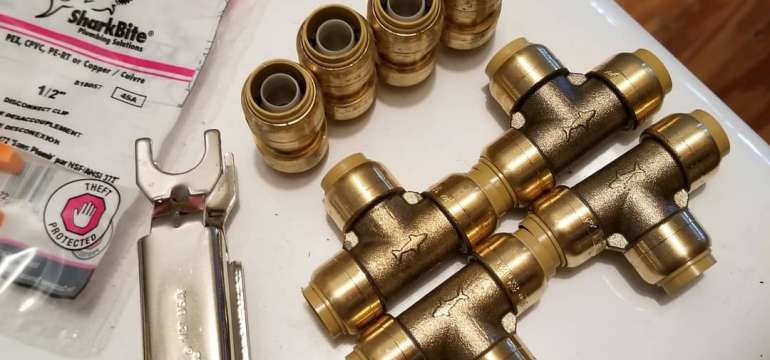SharkBite fittings, a kind of push-fit fittings, are very convenient tools. They allow you to connect two separate pipes without soldering them together. They’re easy, quick, and will save you a lot of time. However, many plumbers feel that there are times when you should use them, and then there are times when you shouldn’t. Before we start, it’s important to have a good understanding of how they work.

SharkBite fittings are composed of three parts, a collet, an O-ring, and a locking mechanism. The collet has a ring of metal teeth that firmly grasp the pipe, the O-rings create a waterproof seal, and the locking mechanism keeps all components together.
SharkBite fittings work well with PEX, CPVC, and hard drawn copper. If you’re using SharkBite fitting with hard drawn copper, make sure the copper is a K, L, or M type.
To use SharkBite fittings, you simply have to push them into the ends of both pipes that you want to connect. It’s that easy. There are no tools needed, and connecting them takes seconds. This is much faster than soldering your pipes together.
When and when not to use SharkBite fittings

Most professional plumbers believe that SharkBite fittings and other kinds of push-fit fittings should only be used as an emergency, temporary fix, and not for any enclosed or permanent plumbing system. However, there is a growing selection of DIYers who would disagree. These select groups of homeowners feel SharkBite fittings are just as strong as soldering.
Some of the criticisms to using SharkBite and other push-fit fittings include push-fit fittings don’t have the credibility that soldering has. Soldering has been around much longer than push-fit fittings.
How long have SharkBite fittings been around? SharkBite is a name brand that was created in the mid-2000s, but push-fit fittings were invented about 30 years ago. Over the years, different brands popped up, including SharkBite and John Guest.
Another possible disadvantage to using SharkBite fittings is that many plumbers feel that these fittings simply aren’t strong enough to create a tough, durable connection. Although there’s no evidence to substantiate that believe, those plumbers simply trust soldering for their permanent plumbing projects. Trying to hire a company that will use push-fit fittings can be difficult sometimes.
So, when should you use SharkBite or another push-fit fitting? Most professionals say that unless you just need a quick, emergency fix, use soldering. However, there are quite a few people who feel push-fit fittings are just as strong as soldering and can be used in all areas of a plumbing system. It really comes down to your choice.
Copper vs. PEX
SharkBites are just one type of push-fit fitting. There are many, but whether you may have to choose your fitting brand based on whether you are using copper or PEX.
When it comes to copper pipes, the only kind of fittings you can use are copper and SharkBite. PEX piping, on the other hand, requires crimp, clamp, or SharkBite fittings. SharkBites are the only brand of fittings that work with both copper and PEX pipes.
Helpful tips when installing SharkBite fittings
☆ If you have any burrs on the end of the pipe, you could potentially damage the O-ring. In this case, a great tool to use is a deburring and gauge tool. It does an excellent job of smoothing the end of the pipe. The gauge is used to mark the depth to insert the pipe into the fitting.
☆ When cutting pipe, never use a hacksaw. What you’ll want to use is a pipe/tubing cutter. You need a clean, smooth cut when using SharkBite or another kind of push-fit fittings in order to make the pipe leak-free.
☆ You do not have to wait until your pipes are completely dry to start using push-fit fittings. If you’re in a hurry, quickly turn off the water, drain as much water as you can, and start connecting your pipes.
☆ Make sure you insert your SharkBite or other kind of fittings all the way. Read the manufacturer’s instructions so you know specifically how far to stick them into the pipe.
☆ Make sure you take your time when inserting your SharkBite or other fittings into the end of the pipes. Jamming them in too quickly could cause damage to the O-ring resulting in a leaky pipe.
☆ If your pipes are PEX, then you’ll have to use a special insert. This insert keeps the pipe from collapsing. The good news is that if you’re using SharkBite, the insert is already built into the fitting.
☆ If you insert your push-fit fitting into the end of the pipe, and then you decide that you need to remove it, you can’t just pull it out. To remove these fittings, you’ll have to press down firmly on the fitting’s release collar, or collet. If you’re using a SharkBite fitting, look for a tiny, plastic ring poking out of the fitting end.
☆ If your push-fit fittings feature “twist and lock” technology, take notice of the nuts located at the ends. These nuts must be tightened to ensure the fitting is completely secure. The “twist and lock” technology was common on the John Guest fittings. It’s important to note that SharkBite fittings don’t have this technology.
☆ Finally, to make your push-fit fitting more secure, you can use optional locking clips. These little devices clip between the fitting body and the collet.
Once you use SharkBite or another kind of push-fit fittings, you’ll understand why their popularity is increasing with plumbers more and more each day. Give them a try. You’ll be glad you did.
- If You Have No Hot Water Pressure, Here’s What You Should Do - December 28, 2021
- What is the Right Shower Drain Pipe Size? - January 25, 2020
- Wet Vent Plumbing, What Is It? How Do You Utilize It? - November 17, 2019

